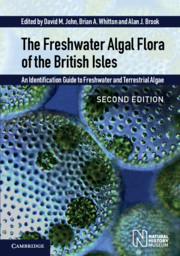 The Freshwater Algal Flora of the British Isles
The Freshwater Algal Flora of the British Isles Book contents
- Frontmatter
- Contents
- The online material (formerly provided in DVD format)
- List of Contributors
- Foreword
- Preface
- Acknowledgements
- Introduction
- Distribution and Ecology
- History of Freshwater Algal Studies in the British Isles
- Field Methods
- Laboratory Methods
- Water Framework Directive
- Cultures of British Freshwater Algae
- Classification
- Key to phyla
- Cyanobacteria (Cyanophyta)
- Phylum Rhodophyta (Red Algae)
- Phylum Euglenophyta (Euglenoids)
- Phylum Cryptophyta (Cryptomonads)
- Phylum Dinophyta (Dinoflagellates)
- Phylum Raphidophyta
- Phylum Haptophyta (Prymnesiophyta)
- Phylum Chrysophyta (Golden Algae)
- Phylum Xanthophyta (Tribophyta) (Yellow-Green Algae)
- Phylum Eustigmatophyta
- Phylum Bacillariophyta (Diatoms)
- Phylum Phaeophyta (Brown Algae)
- Primitive Green Algae (‘PRASINOPHYTA’)
- Phylum Chlorophyta (Green Algae)
- Phylum Glaucophyta
- Glossary
- Standard Form of Authors of Algal Names
- Sources of Illustrations or Material
- References
- Taxonomic Index
- Subject Index
- Plate Saction
- Miscellaneous Endmatter
- Miscellaneous Endmatter
Foreword
Published online by Cambridge University Press: 12 January 2024
- Frontmatter
- Contents
- The online material (formerly provided in DVD format)
- List of Contributors
- Foreword
- Preface
- Acknowledgements
- Introduction
- Distribution and Ecology
- History of Freshwater Algal Studies in the British Isles
- Field Methods
- Laboratory Methods
- Water Framework Directive
- Cultures of British Freshwater Algae
- Classification
- Key to phyla
- Cyanobacteria (Cyanophyta)
- Phylum Rhodophyta (Red Algae)
- Phylum Euglenophyta (Euglenoids)
- Phylum Cryptophyta (Cryptomonads)
- Phylum Dinophyta (Dinoflagellates)
- Phylum Raphidophyta
- Phylum Haptophyta (Prymnesiophyta)
- Phylum Chrysophyta (Golden Algae)
- Phylum Xanthophyta (Tribophyta) (Yellow-Green Algae)
- Phylum Eustigmatophyta
- Phylum Bacillariophyta (Diatoms)
- Phylum Phaeophyta (Brown Algae)
- Primitive Green Algae (‘PRASINOPHYTA’)
- Phylum Chlorophyta (Green Algae)
- Phylum Glaucophyta
- Glossary
- Standard Form of Authors of Algal Names
- Sources of Illustrations or Material
- References
- Taxonomic Index
- Subject Index
- Plate Saction
- Miscellaneous Endmatter
- Miscellaneous Endmatter
Summary
Second edition
It is now nine years since the first edition of this Flora was issued and it is no longer available. Apart from that, major changes have taken place in the classification and taxonomy of the algae. Lastly, there are some 200 verifiable additions to the flora and increased knowledge of various aspects of the ecology and distribution of many taxa. Clearly a new edition is needed, and the editors and contributors are to be congratulated on their conclusion of a major task. They have kept to what can be seen with a light microscope. This does make the identification of some species impossible (e.g. in the genus Mallomonas), but the vast majority of freshwater algae can still be identified in this way.
The results of investigations using electron microscopy and of phylogenetic studies have caused a major revision of the Chlorophyta, although there are some still unresolved problems, notably in Klebsormidium, a cosmopolitan genus containing some of the commonest soil algae. Considerable clarification has been made in the equally common aquatic genus Scenedesmus, pictures of which are legion. The chapter on Cyanobacteria (Cyanophyta) has been enlarged and partially revised and is an especially valuable overview based on the author’s great knowledge of the group. A welcome addition is the inclusion of ‘colourless’ (non-photosynthetic) Euglenophyta. ‘Colourless’ Cryptophyta and Dinophyta are also included. The chapter on Desmids is significantly enlarged; yet less than half of the 900 British species are included. Very helpful additions are the pictures illustrating the common terms used in the description of these algae. Another welcome addition is the short yet masterly chapter on cultures of algae.
Despite the additions made, the new edition is just over 170 pages longer than the first. The CD of that volume is replaced by a DVD which includes a variety of images and articles. The photo catalogue of algae and their habitats is considerably enlarged (now over 1400 images) and the coded checklist of freshwater and terrestrial algae has been brought up to date. There are stunning pictures of desmids along all three axes. The pictures of Vaucheria are also to be highly commended.
The edition is a fine successor to the first and is likely to have an even larger circle of users.
J.W.G. Lund FRS
August 2010
- Type
- Chapter
- Information
- The Freshwater Algal Flora of the British IslesAn Identification Guide to Freshwater and Terrestrial Algae, pp. x - xiiPublisher: Cambridge University PressPrint publication year: 2021


